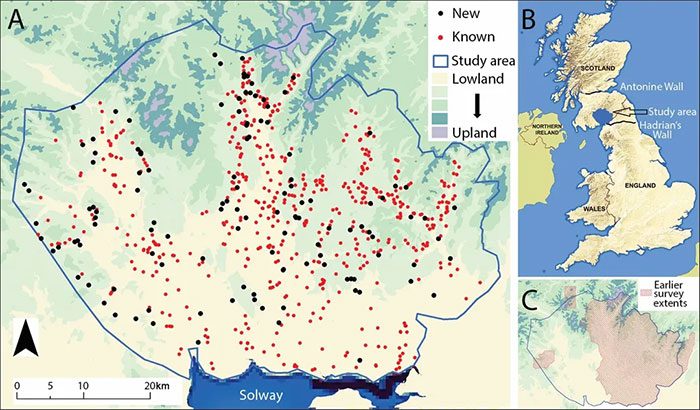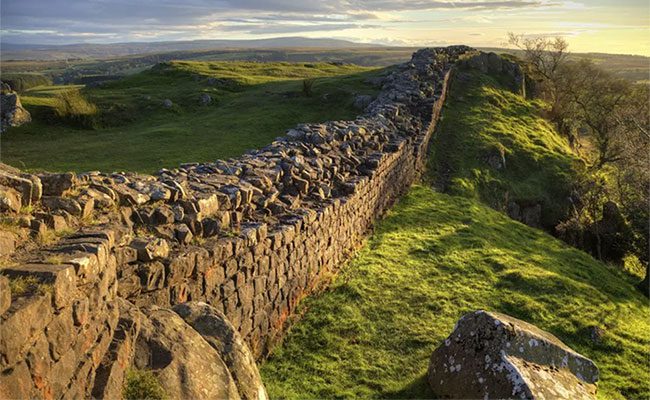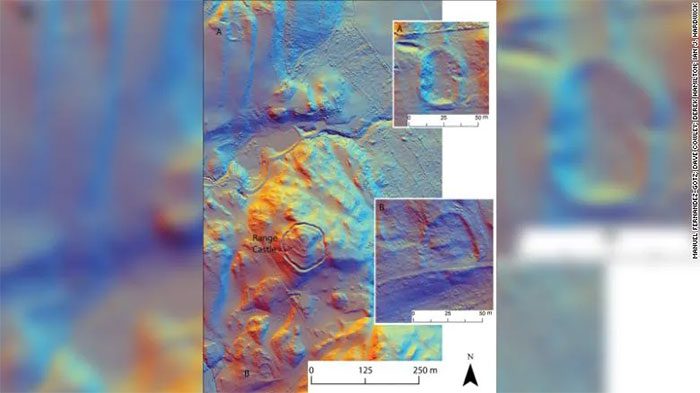Over 100 Iron Age Settlements Discovered Near Hadrian’s Wall in the UK. The study was published in the journal Antiquity.
Specifically, 134 sites corresponding to Indigenous settlements from the time of Roman occupation have been identified.

Map of Iron Age settlements (red dots are discovered, black dots are newly discovered).
The construction of Hadrian’s Wall began in AD 122 in what is now northern England, serving as the northernmost boundary of the Roman Empire. As the ancient Romans pushed further north, they built the Antonine Wall about 20 years later in what is now central Scotland. However, this was only a brief expansion, and the ultimate boundary remained Hadrian’s Wall.
Most studies related to this area have focused on roads, forts, camps, and the iconic walls that characterized the Roman control of northern England. However, Manuel Fernández-Götz, head of archaeology at the University of Edinburgh in Scotland, is more interested in the impact of the Roman Empire on Iron Age Indigenous communities in Britain.
“This is one of the most interesting areas of the Empire, as it not only represents the northernmost frontier of the empire but also because Scotland is one of the very few regions in Western Europe that was not fully controlled by the Roman army. This new discovery also presents a great opportunity to study the impacts of empires on communities at the edges of their political boundaries—a theme relevant to later stages of history,” Fernández-Götz stated via email.

Hadrian’s Wall
The project led by Fernández is titled “Beyond the Wall: Reassessing the Iron Age and Roman Encounters in Northern England,” and it studies an area from the city of Durham in England extending to the southern Highlands of Scotland. The project began in September 2021 and is expected to conclude in August 2024.
The first phase of the research focuses on exploring 1,500 square kilometers around the Burnswark Hill fort in southwestern Scotland, a crucial stronghold for the Roman legions as the Empire pushed northward.
This site is also home to the largest concentration of Roman artifacts in England, providing evidence of the firepower of the ancient Roman army. For centuries, northern England has been described as a “volatile frontier characterized by dynamic patterns of confrontation and exchange between Iron Age communities and the Roman state,” the researchers write.
Due to the limited written records from this period, scientists hope to gain more information through the remnants and landscapes of the area.
Using Lidar terrain scanning technology, Fernández-Götz’s team discovered 134 previously undocumented settlements, despite the area having been thoroughly studied before.

Lidar image showing two new settlements near Range Castle fort
“Here, new technology combined with fresh perspectives has the opportunity to make a difference—a difference in the volume of information,” he said.
With this new discovery, the total number of Iron Age settlements in the area has reached 704. Most of the new sites are small farmhouses. Many architectural structures not only represent the power of the wealthy and ruling classes but also reveal how Iron Age people lived and interacted.
Although conflict with the Roman army was inevitable, through exchange and cooperation, local farmers became a logistical support for the most formidable army of the time.
The locations of the settlements also reveal patterns of organization among the Indigenous communities in terms of time and place. “The importance of the project is that it helps us reconstruct settlement patterns. Individually, they may not stand out, but together, they tell us a lot about the lives of ancient residents,” co-author of the study Dave Cowle noted.
In the coming period, the research team will utilize geophysical tools and carbon dating methods to further investigate the 134 settlements and their builders. Once completed, the project will paint a comprehensive picture of the lives of people before, during, and after the Roman occupation, examining how imperialism disrupted the rhythms of life in Indigenous communities.





















































